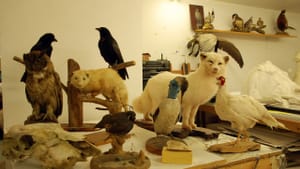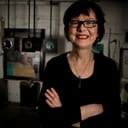Stay in the Loop
BSR publishes on a weekly schedule, with an email newsletter every Wednesday and Thursday morning. There’s no paywall, and subscribing is always free.
An intruder in the studio

Years ago, a good friend visited my studio and, on seeing a particular chair, she became excited. Of all the things she could have settled her attention upon in my studio — my art, others’ art, equipment, taxidermy — she focused upon a simple chair offering nothing noteworthy other than she, too, had the same chair.
My friend’s lack of interest in the studio’s creative process was not in ignorance of art. She was married into the family responsible for one of the largest art collections in the United States. Instead, the chair became an object of self-identification making my studio about the familiar — her.
I was amused by my friend’s reaction, but I also experienced the flattening of the studio’s spatial richness when reduced to a non-event chair that became important because of its connection to her. I felt trespassed upon.
Entering an artist’s studio is tricky business — but why? More importantly, why does the creative process require that personal agendas be left at the door? Is the creative process so vulnerable to potential derailment?
Artists are known to protect their space from intrusion. Vasari writes that Pontormo, the Florentine Mannerist painter (1494-1557), sometimes worked and lived in a tower accessible only by ladder — one he pulled up, preventing others from entering. It is also said that he painted for five years in the Palace of Castello without allowing anyone to see the work. The tower seems a bit excessive; perhaps insane. Working in privacy does not.
Even the hardiest of artists gets derailed in the creative process by an offhand comment, and it is not surprising to hear artists refer to their studios as “hideouts” or “retreats.” Historically, though, artists’ studios were not particularly private; they were workshops.
Public/private space
A student’s studio is somewhat private, but it is also open to critics: Instructors visit studios for critiques. They often intrude with agendas, and I learned at the Pennsylvania Academy of Fine Arts to avoid those critic/instructors who sought to make students into mirrors of themselves.
I welcomed Roswell Weidner’s critiques, despite the fact that the first 10 minutes of every critique were taken up by his retelling the story of an ex-wife long gone for 30 years. A total disconnect, but somehow, the litany of the story seemed to free his eyes so that when he turned to see the art, he saw it with surprise; as if the ex-wife story cleared from his mind preconceptions of what my art should be, thus making his observations very perceptive.
Critic and artist Moe Brooker also saw art with eyes attuned to the work itself. He would say something like “You have two ways to go: Go this way, this will happen; go that way, that will happen,” focusing on the primacy of the visual and not on value judgments of should-have-been-could-have-been.
Both instructors understood how artists must “listen” to both their materials and the process. “Red always comes forward in the picture plane and doesn’t care that you want me to see it in the distance!” is Moe’s response when a painting student insisted on the contrary. Visual experience overrides personal agenda.
Becoming the visitor
I am sensitive to this intrusion of studios when I receive an invitation to be a visiting artist at a prestigious graduate sculpture department. I am invited for two days to critique each student in his or her studio.
I am honored by the invitation. My own students are prisoners, usually not high school graduates, are eager to learn anything, so I wonder, “What do I  have to offer these students who have so much more?” Many of the works are installations, and I know nothing about installations.
have to offer these students who have so much more?” Many of the works are installations, and I know nothing about installations.
I think about Levinas, the philosopher who developed a philosophy of ethics after the Holocaust. Levinas has a unique take on infinity, describing it as that which does not reduce the world to sameness — to the self. The opposite of infinity, therefore, is the self that sees everything through the lens of selfhood — what in a travel vernacular might be described as the “ugly American.”
Ways of listening
I think about listening and realize that it presents a simple way of transcending both myself and my agendas. Accepting that listening is the code-breaker moving me toward infinity and because I know nothing about installations, when I go into the students’ studios, I listen.
What I experience by listening is that eventually, I understand. I ask questions at first simply to elucidate; later questions move me into their space in order to see with their eyes. When this happens, I can ask more challenging questions not derived from me — questions they ask themselves, though they don’t yet realize it. Of course, this takes time, and each 20-minute session grows into an hour.
It becomes obvious that listening also involves an act of trust on the students’ part — accepting me into “their space” — when the last student does not drop her wall. With her, I reverse roles and listen as if I am the student and she is the critic, giving the space she needs to explore her art.
My initial question falls short. The important question is not, “What do I have to offer?” Instead, the question is, “Have I heard what the art is saying without the interference of a me?” Can I step out of myself to really see the art — not as an intellectual exercise but as an emotional exodus abandoning the proverbial, “It reminds me of…”?
Someone might say, “Oh, like doing therapy.” No. Therapy changes listening by institutionalizing it, so listening becomes a professional experience pushed to the edges of commonplace.
Instead, this listening is an ordinary experience that is not only my transit beyond me but also my link into the world, making the act of listening both transcendent and immanent.
In art, the studio (or museum) becomes the place of listening, and the visitor’s comments should be posed not to collapse space to a familiar chair but to expand it.
Above right: The Visitation, Jacopo Pontormo, 1528. Pieve di San Michele in Carmignano, Italy
Sign up for our newsletter
All of the week's new articles, all in one place. Sign up for the free weekly BSR newsletters, and don't miss a conversation.

 Treacy Ziegler
Treacy Ziegler